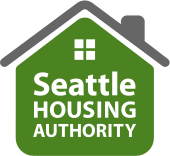SEATTLE—April 22, 2004—As construction continues on the new Community Center at Yesler Terrace, questions about the redevelopment of Yesler Terrace itself are being asked more frequently. Built in 1939, this community was the first public housing development that built by Seattle Housing Authority.
Residents and planners alike have recognized that, sooner or later, these aging structures will need to be replaced. The question looming in the minds of many is, When?
At this time, Seattle Housing has no concrete plans for the redevelopment of Yesler Terrace. However, planners are beginning to discuss it and to consider a general framework for redevelopment. Before serious planning efforts begin, a broad vision for the new neighborhood will be developed, with help from both residents and immediate neighbors, and from the wider community.
Seattle Housing expects that serious planning efforts will not begin until mid-2005 at the earliest. And the planning process itself will take two to three years, possibly longer. In the meantime, the agency will continue to collect background information in preparation for the planning effort.
When the planning process formally begins, a number of important principles will guide the effort.
First, on a one-for-one basis, every unit presently at Yesler Terrace will be replaced in Seattle. Seattle Housing will continue their excellent track record in this area. SHA has already purchased 21 replacements for the Yesler units demolished to make room for the new community center. A total of 857 units in the four HOPE VI redevelopments have been replaced so far. This is already 38 percent of the goal.
Second, SHA expects to build a portion of the Yesler replacement units at the current site. However, until a vision and plan are created, it is impossible to know how many low-income units will be replaced on site.
One key variable in the planning will be determining the number of total units that can be built on the site. It is anticipated that the new Yesler Terrace will most likely be a mixed-income community, with about a third of the total units being low-income rentals. It may also have some mixed-use elements as well, such as retail or office uses.
Once the development process at Yesler begins, it will most likely be accomplished over an extended period in small stages, a block or two at a time, over several years. This means that many Yesler residents may be able to stay on site during the process.
All residents who are required to move from Yesler Terrace will receive relocation benefits and assistance finding housing. At some point, several years from now, an announcement will be made as the official beginning date for the redevelopment project. From that date on, all Yesler Terrace residents who are required to move will be eligible for these benefits.
As part of the redevelopment planning process, there will be an extensive outreach program to solicit ideas from residents and neighbors. Seattle Housing will establish a formal Yesler Advisory Committee, which will include residents and other community stakeholders, as one avenue for community involvement. There will be additional less formal efforts as well.
The Seattle Housing Authority Board of Commissioners has made the redevelopment of Yesler a priority for the next ten years. With the ongoing withdrawal of federal support for low-income housing, the redevelopment of Yesler Terrace is a key component in Seattle Housing's strategy to continue to serve Seattle's low-income residents.
